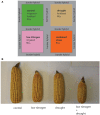Phenotype Uniformity in Combined-Stress Environments has a Different Genetic Architecture than in Single-Stress Treatments
- PMID: 22645526
- PMCID: PMC3355809
- DOI: 10.3389/fpls.2011.00012
Phenotype Uniformity in Combined-Stress Environments has a Different Genetic Architecture than in Single-Stress Treatments
Abstract
For crop production it is desirable for the mapping between genotype and phenotype to be consistent, such that an optimized genotype produces uniform sets of individual plants. Uniformity is strongly selected in breeding programs, usually automatically, as harvest equipment eliminates severely non-uniform individuals. Uniformity is genetically controlled, is known to be increased by interplant competition, and is predicted to increase upon abiotic stress. We mapped maize loci controlling genotype by environment interaction in plant height uniformity. These loci are different than the loci controlling mean plant height. Uniformity decreases upon combining two abiotic stresses, with alleles conferring greater uniformity in a single stress showing little improvement in a combined stress treatment. The maize B73 and Mo17 inbreds do not provide segregating alleles for improvement in plant height uniformity, suggesting that the genetic network specifying plant height has a past history of selection for robustness.
Keywords: QTL; Zea mays L.; abiotic; combined stress; maize; multiple stress; phenotype stability; uniformity.
Figures




References
-
- Baker R. (1984). “Some of the open pollinated varieties that contributed the most to modern hybrid corn,” in Illinois Corn Breeders School. University of Illinois, Urbana, IL
-
- Boomsma C. R., Santini J. B., West T. D., Brewer J. C., McIntyre L. M., Vyn T. J. (2010). Maize grain yield responses to plant height variability resulting from crop rotation and tillage system in a long-term experiment. Soil Tillage Res. 106, 227–24010.1016/j.still.2009.12.006 - DOI
-
- Cone K. C., McMullen M. D., Bi I. V., Davis G. L., Yim Y.-S., Gardiner J. M., Polacco M. L., Sanchez-Villeda H., Fang Z., Schroeder S. G., Havermann S. A., Bowers J. E., Paterson A. H., Soderlund C. A., Engler F. W., Wing R. A., Coe E. H. (2002). Genetic, physical, and informatics resources for maize. On the road to an integrated map. Plant Physiol. 130, 1598–160510.1104/pp.012245 - DOI - PMC - PubMed
LinkOut - more resources
Full Text Sources
Other Literature Sources
Molecular Biology Databases
Miscellaneous

